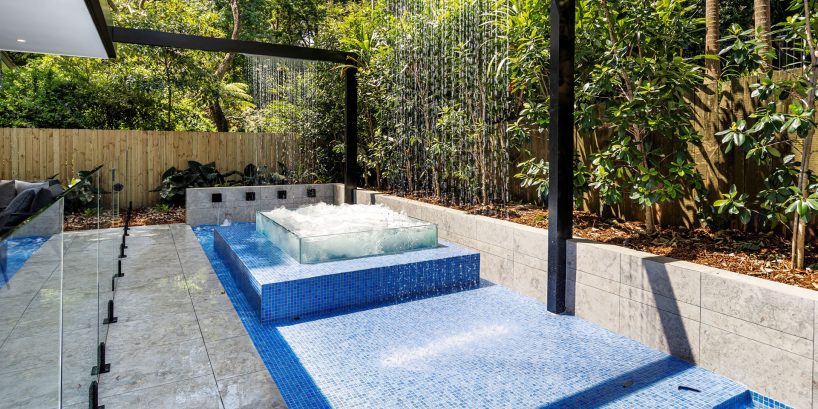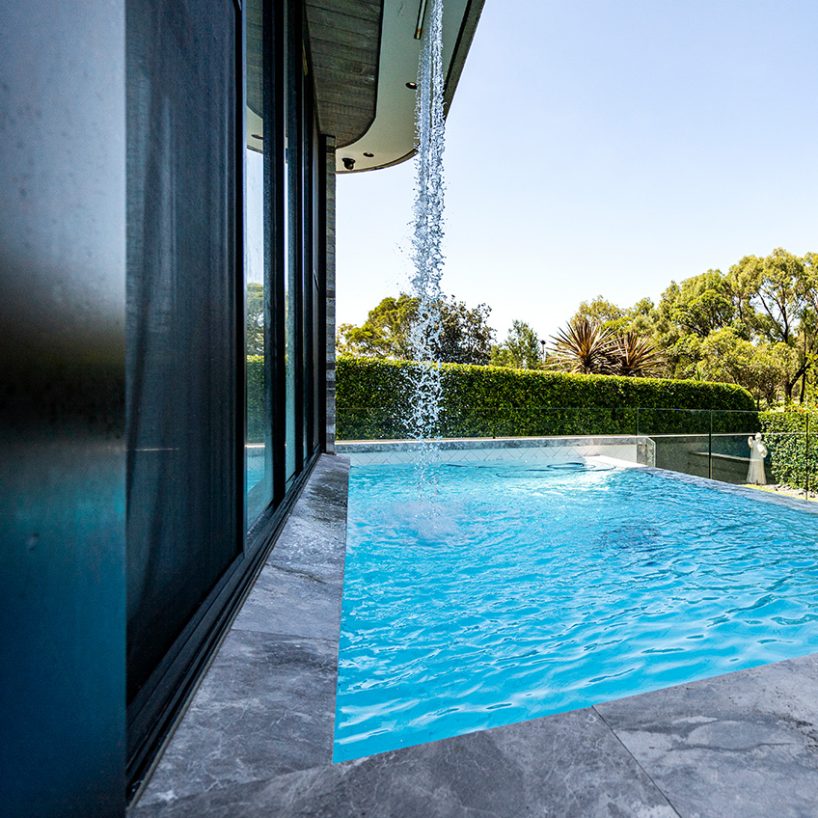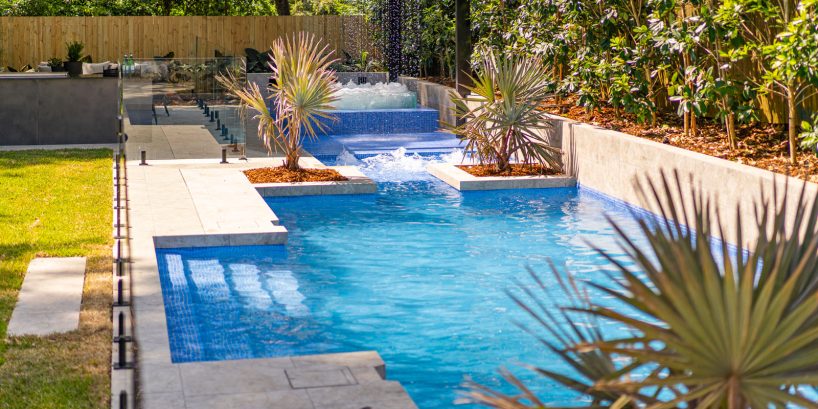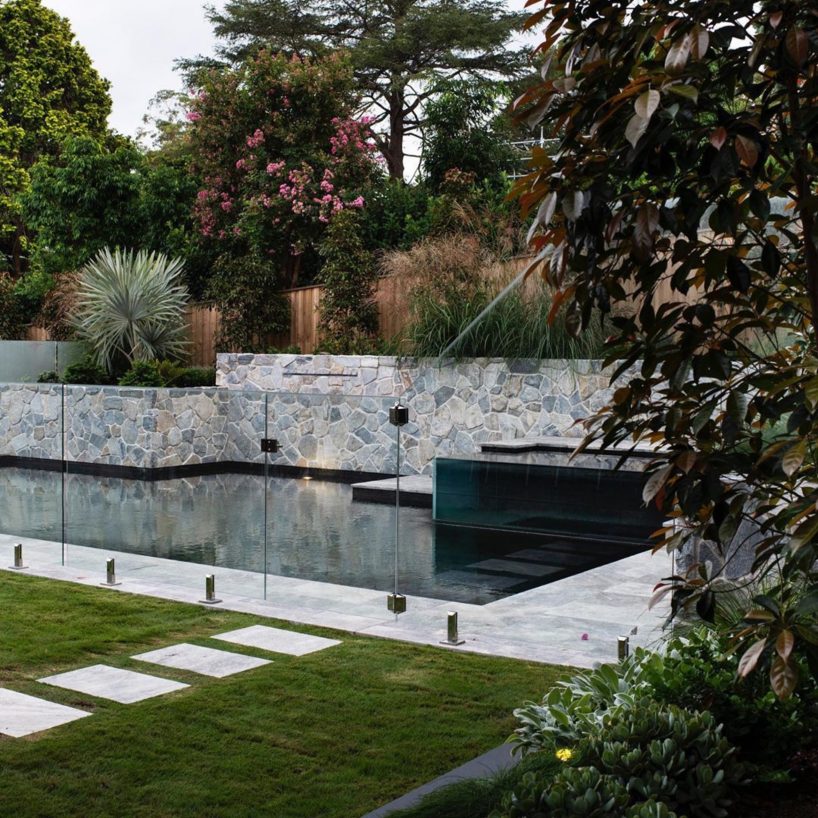Create a refined outdoor retreat with carefully considered pool pavers. The right choice of materials, tones and layout can elevate this space from a simple splash zone into a calm and cohesive architectural feature.
For a swimming pool space that blends luxury with lasting performance, natural stone and porcelain are both standout choices. Their refined textures, durability and versatility make it easy to complement any alfresco aesthetic.
Whether you’re refreshing an existing pool or designing a new outdoor landscape, this guide explores our favourite pool paving ideas for 2026. Read on for design inspiration, practical advice and expert tips.
Pool paver design ideas for your private oasis

1. Intricate mosaic pool tiles
Mosaic tiles add an air of artistry to any pool. Available in an extensive spectrum of colours, they allow you to tailor the water’s appearance — from deep ocean blues and lagoon greens to crisp, luminous whites and elegant charcoal tones.
Their small format and modular patterns also open the door to expressive design. Borders, gradients, motifs and feature inlays can all be created, giving your pool a distinctive identity that feels personal and visually refined.
Beyond their beauty, vibrant glass mosaic tiles are crafted to withstand the demands of pool environments. Discover a smooth surface that is resistant to water, salt and pool chemicals.

2. Subtle travertine pool pavers
Travertine has long been a favourite for pool surrounds thanks to its natural warmth, gentle texture and enduring appeal. Its subtle veining and tonal variation create an organic finish that sits beautifully within both contemporary and classic landscapes.
Typically available in cream and soft grey hues, travertine complements a wide range of styles without overwhelming the space. It also stays naturally cool underfoot — a major advantage in hot Australian summers.
With the right sealing and care, this stone ages gracefully, developing a character that feels lived-in, relaxed and effortlessly refined. Its combination of comfort, beauty and practicality is why it remains one of the most trusted materials for Australian pool areas.

3. Luxurious marble pool pavers
With its elegant veining and polished sophistication, marble pavers bring unmistakable sophistication to pool surrounds.
For a light and luminous look, Arabescato marble offers soft grey veining across a clean white base, producing a calming and ethereal effect. For something moodier and bolder, Oscar Grey marble introduces deeper grey tones with refined mineral movement.
Whichever variant you choose, marble performs wonderfully around pools when finished with a textured, slip-resistant surface and sealed for long-lasting protection.

4. Contemporary granite pool pavers
Granite is celebrated for its strength, subtle texture and architectural presence. Its naturally speckled surface adds visual depth without distracting from the broader outdoor design.
With its deep charcoal tones, this natural stone delivers a sleek, contemporary aesthetic ideal for homes with modern lines or monochromatic palettes.
When paired with minimalist landscaping and streamlined pool edging, granite creates a space that feels strong, grounded and confidently refined.
Moreover, its excellent durability and slip resistance make it a reliable choice for high-traffic pool areas, maintaining both beauty and performance over time.

5. Timeless limestone pavers
Limestone lends a soft, understated elegance to your swimming pool area. Its fine grain and muted tonal movement create a gentle, calming visual effect that accentuates greenery, stonework and coastal palettes beautifully.
Often featuring cool greys, pale creams and warm neutrals, this stone introduces a heritage-inspired finish that suits both modern and traditional landscapes. It also pairs effortlessly with timber, whitewashed walls and native plantings.
With careful sealing and maintenance, limestone maintains its refined appearance while developing a rich patina.

6. Porcelain pool pavers
Enjoy unparalleled practicality with porcelain pool pavers. Made from high-quality clays and fired at high temperatures, this dense, non-porous paving stands up beautifully to sun, water and frequent outdoor use.
This material is particularly well-suited to swimming pool areas thanks to its low water absorption, strong resistance to fading and staining, and slip-resistant finishes for wet areas.
Plus, with no sealing required and easy cleaning, porcelain maintains its original appearance with minimal upkeep.
Porcelain’s design versatility is another major draw.
Available in a broad range of colours, textures and stone-inspired finishes, it can support a minimalist, modern atmosphere or a more relaxed coastal feel. Create a seamless, uncluttered visual effect around the pool with large-format options.

7. A striking stone pool feature wall
A stone feature wall can transform your pool area into a sophisticated focal point. Whether used to frame the pool, highlight a seating area or integrate a waterfall or blade fountain, stone cladding introduces new levels of texture and depth.
Choose between soft, layered limestone, rugged split-face panels, or sleek, honed stone to match your desired atmosphere.
Paired with thoughtful lighting, this architectural anchor serves as a beautiful backdrop for both morning dips and midnight swims.
Benefits of natural stone and porcelain pool paving
Weather and water resilience
Pool surrounds demand materials that can stand up to sun, water and constant outdoor use — and both natural stone and porcelain excel in these conditions.
Travertine, limestone and granite remain stable under extreme heat, resist moisture absorption and handle temperature fluctuations without losing their integrity.
Porcelain pavers are engineered to be exceptionally tough. They are non-porous, UV-stable and resistant to fading, chlorine and salt exposure, making them ideal for saltwater pools and coastal environments.
This resilience means your pool paving will continue to look refined and perform beautifully, season after season, with minimal intervention.
Infinite design possibilities
Natural stone and porcelain offer design versatility that can transform your pool area into a seamless extension of your home’s architecture.
Natural stone brings organic texture and subtle tonal variation that feels inviting, timeless and relaxed. Meanwhile, porcelain can achieve a sleek, contemporary surface with clean lines and large-format sizing for a seamless, modern aesthetic.
Both materials come in a wide range of colours, finishes and edge profiles, allowing you to create a pool environment that feels softly coastal, resort-luxurious or elegantly architectural. Coping and paving can also be matched for a continuous and considered result.
Poolside safety
Natural stones like limestone, granite and certain travertine finishes offer naturally textured surfaces that provide secure footing even when wet.
Porcelain designed for exterior use is manufactured with specialised slip-resistant finishes (often classified as R11 or P5), offering exceptional grip without compromising the smooth, elegant look of the paving.
Greater property value
Well-chosen pool paving does more than improve functionality; it enhances your entire outdoor area. Natural stone delivers a premium, resort-like look that never dates, while porcelain provides longevity with minimal upkeep.
A beautifully finished pool space becomes a lifestyle feature, one that can increase market appeal and long-term property value.
As both materials are durable and visually enduring, they offer a strong return on investment compared to lower-cost, short-lifespan alternatives.
How to choose the perfect pavers for your pool
| Feature | Natural Stone | Porcelain |
|---|---|---|
| Look & Feel | Organic texture, timeless character | Sleek, modern, consistent finish |
| Comfort Underfoot | Naturally cool in warm climates | Can stay cool depending on colour/finish |
| Colour | Colours can vary, with each piece featuring unique shades and patterns | Colour can be uniform or designed to mimic natural stone |
| Maintenance | Requires sealing every few years | No sealing required |
| Slip Resistance | Available in textured finishes | Available in slip-rated outdoor finishes |
| Design Flexibility | Rich variation in tone and pattern | Large formats and precise uniformity |
| Best For | Coastal, luxury and classic outdoor spaces | AMinimalist, contemporary and low-maintenance spaces |
Local climate
Pool areas are exposed to direct sunlight, heat, moisture, chlorine or saltwater, and seasonal temperature changes — all of which influence how different paving materials perform over time.
If you live in a warm or high-sun region, consider how hot the surface may become during summer. Lighter-coloured stones and porcelain tend to reflect heat, helping keep the area comfortable under bare feet. Darker pavers can look striking, but they may absorb more heat, which can affect usability through the hottest parts of the day.
For coastal or saltwater pool environments, prioritise materials with a high tolerance to salt and mineral exposure. Natural stones like granite and travertine are well-suited to these conditions when sealed correctly. Porcelain is naturally non-porous and highly resistant to salt and chemicals, making it an excellent low-maintenance choice for coastal climates.
In tropical or rainy regions, the key consideration is how quickly surfaces dry. Select pavers with a slip-resistant texture and ensure correct drainage so water doesn’t pool on the surface. This prevents algae growth and maintains safety while keeping the paving looking clean and dry.
By taking into account heat, water exposure, salt levels and seasonal climate shifts, you’ll be able to choose pavers that not only look exceptional but also perform reliably for years to come.
Surrounding features
Small details in your pool area can have a noticeable impact on how well your paving performs long-term.
For example, shade patterns throughout the day will change how warm the surface becomes and how quickly it dries after swimming.
Areas in full sun often benefit from lighter, cooler-feeling pavers.
Also consider nearby landscaping. Leaves, organic debris and garden beds positioned close to the pool can introduce moisture, tannins and soil particles over time.
In these settings, a material such as porcelain, which is non-porous and easy to rinse clean, may be the most practical option. In more open, low-debris surroundings, natural stone can flourish and develop a soft, elegant patina as it settles into the environment.
By observing how your outdoor space behaves in different weather and throughout the day, you’ll gain valuable insight into which paving material will offer not just beauty, but longevity, comfort and effortless usability.
Outdoor aesthetics
Your pool paving should feel like a natural extension of your home. Look closely at the architectural features, exterior colour palette and overall mood of your outdoor area.
For a soft, refined and timeless feel, travertine and limestone offer natural variation and warmth. If your style is more contemporary, porcelain delivers a clean, streamlined look with minimal visual interruption.
Choosing tones and textures that complement your landscaping, pool surrounds, and interior flooring will help create a seamless indoor-outdoor flow.
Maintenance requirements
Each paving material comes with its own care requirements.
Natural stone provides enduring beauty, but because it’s porous, we recommend periodic sealing to protect the surface.
Porcelain pavers are non-porous and do not require sealing, making them a strong choice for those who prefer minimal upkeep.
With thoughtful product selection and occasional cleaning, both options can retain their elegant finish for many years.
Comfort underfoot
Your pool area is a barefoot space, so comfort matters. Lighter stones and porcelain in soft, neutral tones generally stay cooler in the sun.
When reviewing samples, consider how the texture feels. It should be smooth enough to enjoy, yet slip-resistant when wet.
Slip resistance
Safety is paramount around any pool. Look for pavers that are specifically suited to wet areas. The texture should be subtle, secure and visually balanced, preserving the refined aesthetic of the space without compromising safety or usability.
Colour and heat absorption
The colour of your pavers influences both the atmosphere and the temperature of the surface.
Lighter colours promote a soft, coastal calm and remain cooler.
Mid-tone neutrals create a modern and understated elegance.
Darker tones feel bold and architectural, but may warm up more in direct sun.
Aim for a palette that complements your water colour, surrounding materials and the overall tone of your home.
FAQs
Typically made from natural stone or porcelain, pool paving is the hard surface laid around the water’s edge to create a comfortable, practical and visually cohesive outdoor space. A paver is thicker than a regular tile.
The colour, texture and layout of these pavers help define the look and feel of the entire pool area – whether you’re aiming for a coastal feel, a contemporary architectural finish or a classic natural stone look.
Pavers help create a safe and stable surface to walk on when the area is wet, which is essential around a pool. They also reduce dirt and garden material being tracked into the water, helping keep your pool cleaner for longer.
Beyond the practical benefits, pavers are a design statement. They shape the atmosphere of the space, adding texture, warmth and a sense of sophistication that transforms your pool from a functional amenity to a truly beautiful feature.
In Australia, pool areas must prioritise safety. Choose pavers with a slip-resistant surface rating suitable for wet areas to reduce the risk of slipping. Adequate drainage is also essential to prevent water pooling on the surface.
For the pool edge, use pool coping designed to provide a smooth, comfortable boundary without sharp edges.
While regulations vary slightly by state, working with an experienced installer ensures your pool paving meets Australian standards and complements your landscaping and pool surrounds with a premium, well-finished result.
The best grout colour for pool paving is one that complements the tone of your pavers and creates a seamless, cohesive finish. In most luxury outdoor spaces, homeowners choose grout that blends rather than contrasts.
For light natural stone such as travertine or limestone, a soft beige, cream, or warm grey grout helps maintain a calm, resort-style feel. With cooler-toned porcelain, pale greys or stone-matched neutrals create a clean, modern look.
A closely matched grout colour also has practical benefits — it draws less attention to joints and improves the overall visual flow of the space.
The result is a pool area that feels refined, unified and beautifully considered from every angle.
If you’re using natural stone, we strongly recommend sealing. As natural stone is porous, sealing helps protect it from stains, salt, moisture absorption and weathering, keeping it looking its best for many years.
Porcelain tile and pavers, however, do not require sealing. Naturally dense and non-porous, they resist moisture and marking on their own and are very simple to maintain.
Most pool paving is designed to be low maintenance, but a few simple habits will keep the space looking beautifully cared for.
Regularly hose down the area to remove salt, sunscreen and pool chemicals. Avoid harsh chemical cleaners or high-pressure washing, as they can damage surfaces over time.
If you’ve chosen natural stone, sealing it every few years will protect against moisture absorption, fading and staining.
With the right care, your swimming pool paving will age gracefully and retain its refined, resort-style feel.
Add the finishing touch with cohesive pool coping
Also known as a drop-down, pool coping refers to specially made tiles designed to sit neatly over the pool’s perimeter for a clean, continuous edge. This defined border helps visually frame the water and provides a polished transition between the pool and its surrounding paving.
When pool coping matches or complements your surrounding pavers, the result is a seamless and cohesive finish that feels intentional and well-resolved.
You can choose from several coping profiles, including bullnose, square edge, and drop edge. Bullnose styles offer a softer, rounded finish, while square and drop edges create a more contemporary look and feel.
In some designs, a standard natural stone paver can also be used as coping. The organic texture and hand-cut look of the edges of stone can create an integrated, relaxed finish that elevates the surrounding landscape.

Explore premium pool paver options with Marble Plus
Pavers play a prime role in how your pool area looks, feels and functions. The right paving can upgrade this space into a serene sanctuary — one that enhances your home’s architecture with enduring comfort and style.
At Marble Plus, we offer an exquisite selection of porcelain and natural stone pavers for swimming pools. From the soft, organic warmth of travertine to the clean sophistication of porcelain, you’ll find materials to suit every taste and lifestyle.
Our knowledgeable team in Sydney and Brisbane can guide you through tones, textures and slip-resistant finishes to help you choose the perfect solution for your swimming pool. To get started, visit a showroom near you.


